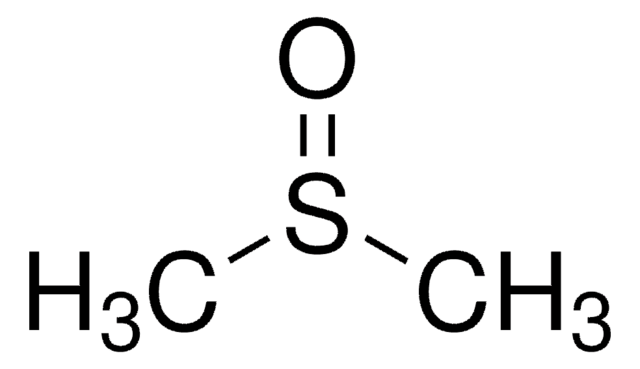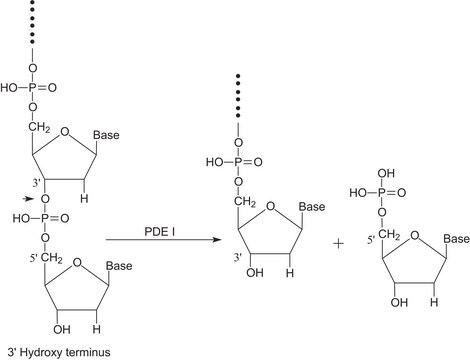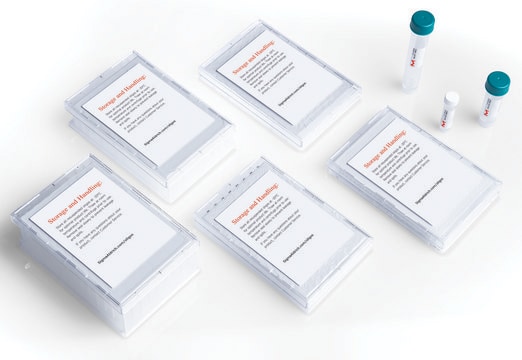N1665
5′-Nucleotidase human
recombinant, expressed in CHO cells, vial of 6-12 μg
Synonyme(s) :
CD73, NT5E, ecto-5′-nucleotidase
Se connecterpour consulter vos tarifs contractuels et ceux de votre entreprise/organisme
About This Item
Numéro CAS:
Numéro MDL:
Code UNSPSC :
12352204
Nomenclature NACRES :
NA.54
Produits recommandés
Produit recombinant
expressed in CHO cells
Niveau de qualité
Description
contains a C-terminal 6-His tag
Essai
≥90% (SDS-PAGE)
Forme
solution
enzyme activity
≥15 units/mg protein
Poids mol.
~61 kDa by SDS-PAGE (reducing)
Conditionnement
vial of 6-12 μg
Impuretés
≤1.0 EU/μg endotoxin
Numéro d'accès NCBI
Conditions d'expédition
dry ice
Température de stockage
−70°C
Informations sur le gène
human ... NT5E(4907)
Description générale
5′-Nucleotidase is an extracellular enzyme found in a wide variety of mammalian cells. It helps to accelerate the hydrolysis reaction of phosphate group from 5′ nucleotides, resulting in corresponding nucleosides.
Actions biochimiques/physiologiques
5′-Nucleotidase has various clinical significances. It is a key molecule in the regulation of cancer cells proliferation, migration and invasion in vitro tumor angiogenesis, and tumor immune escape in vivo. Due to this important role, the enzyme is a potential target for cancer research. It is also involved in salvage of extracellular nucleotides and plays a key role in the control of tissue homeostasis.
5′-nucleotidase, also known as CD73, is an extracellular enzyme that converts nucleoside-5′−monophosphates to nucleosides with a substrate preference of AMP. Native 5′-nucleotidase is a GPI-anchored protein whose exporession is upregulated by hypoxia. 5′-nucleotidase has many functions in vivo including the generation of extracellular adenosine.
Définition de l'unité
One unit will hydrolyze 1.0 μmole of inorganic phosphorus from adenosine 5′-monophosphate per min at pH 9.0 at 37 °C.
Forme physique
Supplied as a solution containing Tris, NaCl, CaCl2, and 20% glycerol.
Code de la classe de stockage
10 - Combustible liquids
Classe de danger pour l'eau (WGK)
WGK 3
Point d'éclair (°F)
Not applicable
Point d'éclair (°C)
Not applicable
Faites votre choix parmi les versions les plus récentes :
Déjà en possession de ce produit ?
Retrouvez la documentation relative aux produits que vous avez récemment achetés dans la Bibliothèque de documents.
F W Sunderman
Annals of clinical and laboratory science, 20(2), 123-139 (1990-03-01)
This review delineates the subcellular distribution, biochemical characteristics, and metabolic functions of 5'-nucleotidase (5'NT), summarizes the analytical biochemistry of 5'NT, and assesses the clinical significance of 5'NT determinations in body fluids, cells, and tissues. Salient aspects of the clinical biochemistry
Zhao-wei Gao et al.
BioMed research international, 2014, 460654-460654 (2014-08-16)
Purinergic signaling has emerged as an important player in cancer progression and is regulated by a series of nucleotidases. Among the enzyme cascade, CD73, which catelyzes AMP breakdown to adenosine, has been found to be overexpressed in many types of
5'-Nucleotidase: molecular structure and functional aspects.
H Zimmermann
The Biochemical journal, 285 ( Pt 2), 345-365 (1992-07-15)
Isolation of a plasma-membrane subfraction from rat liver containing an insulin-sensitive cyclic-AMP phosphodiesterase.
P D House et al.
European journal of biochemistry, 24(3), 429-437 (1972-01-21)
Anna Wilk et al.
Scientific reports, 10(1), 651-651 (2020-01-22)
Changes in nicotinamide adenine dinucleotide (NAD+) levels that compromise mitochondrial function trigger release of DNA damaging reactive oxygen species. NAD+ levels also affect DNA repair capacity as NAD+ is a substrate for PARP-enzymes (mono/poly-ADP-ribosylation) and sirtuins (deacetylation). The ecto-5'-nucleotidase CD73
Notre équipe de scientifiques dispose d'une expérience dans tous les secteurs de la recherche, notamment en sciences de la vie, science des matériaux, synthèse chimique, chromatographie, analyse et dans de nombreux autres domaines..
Contacter notre Service technique








